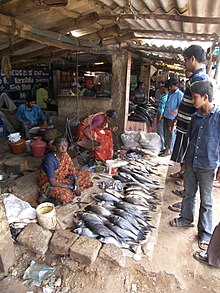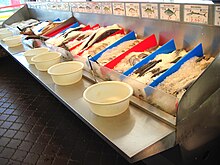
Fishery can mean either the enterprise of raising or harvesting fish and other aquatic life or, more commonly, the site where such enterprise takes place. Commercial fisheries include wild fisheries and fish farms, both in freshwater waterbodies and the oceans. About 500 million people worldwide are economically dependent on fisheries. 171 million tonnes of fish were produced in 2016, but overfishing is an increasing problem, causing declines in some populations.

Overfishing is the removal of a species of fish from a body of water at a rate greater than that the species can replenish its population naturally, resulting in the species becoming increasingly underpopulated in that area. Overfishing can occur in water bodies of any sizes, such as ponds, wetlands, rivers, lakes or oceans, and can result in resource depletion, reduced biological growth rates and low biomass levels. Sustained overfishing can lead to critical depensation, where the fish population is no longer able to sustain itself. Some forms of overfishing, such as the overfishing of sharks, has led to the upset of entire marine ecosystems. Types of overfishing include growth overfishing, recruitment overfishing, and ecosystem overfishing.
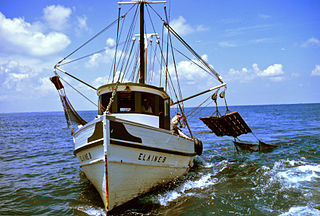
The fishing industry includes any industry or activity that takes, cultures, processes, preserves, stores, transports, markets or sells fish or fish products. It is defined by the Food and Agriculture Organization as including recreational, subsistence and commercial fishing, as well as the related harvesting, processing, and marketing sectors. The commercial activity is aimed at the delivery of fish and other seafood products for human consumption or as input factors in other industrial processes. The livelihood of over 500 million people in developing countries depends directly or indirectly on fisheries and aquaculture.

A maguro bōchō, or maguro kiri bōchō, is an extremely long, highly specialized Japanese knife that is commonly used to fillet tuna, as well as many other types of large ocean fish.
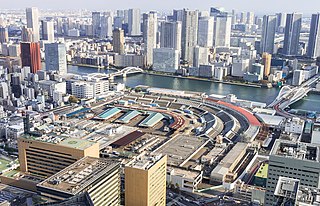
Tsukiji Market is a major tourist attraction for both domestic and overseas visitors in Tokyo. The area contains retail markets, restaurants, and associated restaurant supply stores. Before 2018, it was the largest wholesale fish and seafood market in the world. The market opened on 11 February 1935 as a replacement for an older market that was destroyed in the 1923 Great Kantō earthquake. It was closed on 6 October 2018, with wholesale operations moving to the new Toyosu Market.

Tsukiji (築地) is a district of Chūō, Tokyo, Japan. Literally meaning "reclaimed land", it lies near the Sumida River on land reclaimed from Tokyo Bay in the 18th century during the Edo period. The eponymous Tsukiji fish market opened in 1935 and closed in 2018 when its operations were moved to the new Toyosu Market.

Billingsgate Fish Market is located in Poplar in London. It is the United Kingdom's largest inland fish market. It takes its name from Billingsgate, a ward in the south-east corner of the City of London, where the riverside market was originally established. In its original location in the 19th century, Billingsgate was the largest fish market in the world.
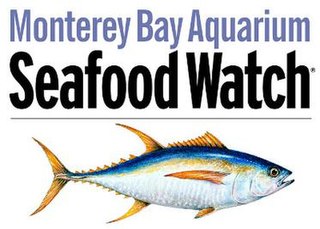
Seafood Watch is a sustainable seafood advisory list, and has influenced similar programs around the world. It is best known for developing science-based seafood recommendations that consumers, chefs, and business professionals use to inform their seafood purchasing decisions.

A marketplace, market place or just market is a location where people regularly gather for the purchase and sale of provisions, livestock, and other goods. In different parts of the world, a marketplace may be described as a souk, bazaar, a fixed mercado (Spanish), or itinerant tianguis (Mexico), or palengke (Philippines). Some markets operate daily and are said to be permanent markets while others are held once a week or on less frequent specified days such as festival days and are said to be periodic markets. The form that a market adopts depends on its locality's population, culture, ambient and geographic conditions. The term market covers many types of trading, as market squares, market halls and food halls, and their different varieties. Thus marketplaces can be both outdoors and indoors, and in the modern world, online marketplaces.

A factory ship, also known as a fish processing vessel, is a large ocean-going vessel with extensive on-board facilities for processing and freezing caught fish or whales. Modern factory ships are automated and enlarged versions of the earlier whalers, and their use for fishing has grown dramatically. Some factory ships are equipped to serve as a mother ship.
Sustainable seafood is seafood that is caught or farmed in ways that consider the long-term vitality of harvested species and the well-being of the oceans, as well as the livelihoods of fisheries-dependent communities. It was first promoted through the sustainable seafood movement which began in the 1990s. This operation highlights overfishing and environmentally destructive fishing methods. Through a number of initiatives, the movement has increased awareness and raised concerns over the way our seafood is obtained.
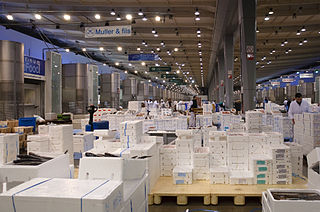
Fish marketing is the marketing and sale of fish products.

China has one-fifth of the world's population and accounts for one-third of the world's reported fish production as well as two-thirds of the world's reported aquaculture production. It is also a major importer of seafood and the country's seafood market is estimated to grow to a market size worth US$53.5 Billion by 2027.

The coastline of the Russian Federation is the fourth longest in the world after the coastlines of Canada, Greenland, and Indonesia. The Russian fishing industry has an exclusive economic zone (EEZ) of 7.6 million km2 including access to twelve seas in three oceans, together with the landlocked Caspian Sea and more than two million rivers.

Toyosu (豊洲) is neighborhood in Kōtō, Tokyo. Toyosu has six numbered chome ("blocks"). It is the location of the wholesale Toyosu Market, which took the role of the Tsukiji fish market after it became solely a tourist attraction.

La Nueva Viga Market is the largest seafood market in Mexico and the second largest in the world after the Toyosu Market in Japan. It is located in Mexico City far inland from the coast, because of historical patterns of commerce in the country. The market handles 1,500 tons of seafood daily, representing about 60% of the total market. Most of the seafood is distributed to the Mexico City metropolitan area and the states surrounding it, but there is distribution to other states and abroad.
The following outline is provided as an overview of and topical guide to the fishing industry:

Spain is an eminently maritime country with a long continental shelf running along the entire periphery of the Spanish coast. This narrow continental shelf is extremely rich in fish resources since the shelf is close to land.

The Toyosu Market is a wholesale market in Tokyo, located in the Toyosu area of the Kōtō ward. There are two markets for seafood, one for general wholesale and one for bidding, and one market for fruits and vegetables, with each in its own building. Tourists can observe the auction market on a second floor viewing deck. There are restaurants with fresh seafood and produce from the market and shops. The market is built on reclaimed land in Tokyo Bay, and replaces the historic Tsukiji fish market, which now is a major tourist attraction. Auction tours, events, merchandise sales and restaurants can be used by general consumers and tourists. When it opened on 11 October 2018, it became the largest wholesale fish market in the world.
Jingshen Seafood Market or Chingshen Seafood Market is a marketplace in the Fengtai district of Beijing.
